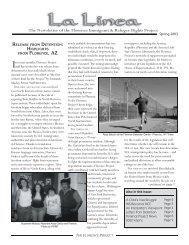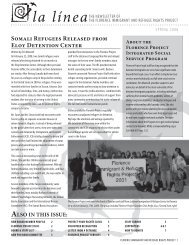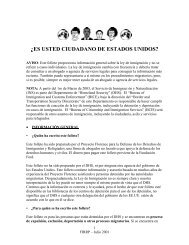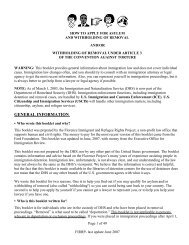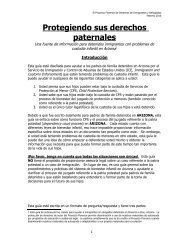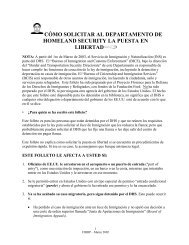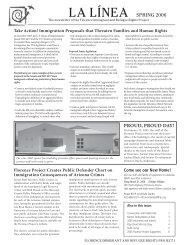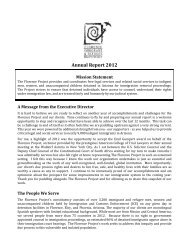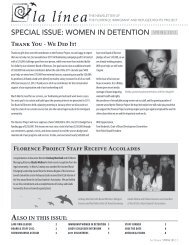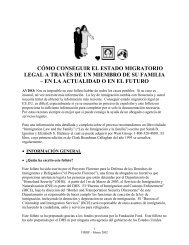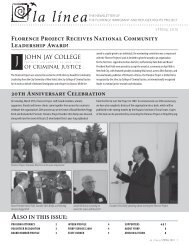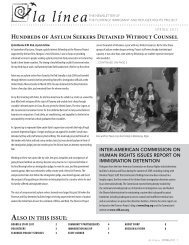quick reference chart and annotations for determining immigration ...
quick reference chart and annotations for determining immigration ...
quick reference chart and annotations for determining immigration ...
You also want an ePaper? Increase the reach of your titles
YUMPU automatically turns print PDFs into web optimized ePapers that Google loves.
Immigrant Legal Resource Center, Florence Immigrant <strong>and</strong> Refugee Rights Project,<br />
Maricopa County Public Defender August 2012<br />
Also, under Matter of Silva-Trevino, supra, the <strong>immigration</strong> judge might elect to look beyond the record<br />
of conviction to determine the underlying conduct.<br />
In practice, <strong>immigration</strong> judges are more likely to find this is not a CMT if the factual basis states<br />
that the identity was used <strong>for</strong> employment purposes <strong>and</strong> involved a fictitious person. Whenever possible,<br />
defense counsel should specifically plead to this as a factual basis; if this is not possible, plead to the<br />
generic language of the statute.<br />
Aggravated Felony: To prevent an aggravated felony conviction as theft, obtain a sentence<br />
imposed of less than a year. If there was a loss to the victim or victims of $10,000 or more, this will<br />
likely be removable as an aggravated felony <strong>for</strong> fraud, regardless of whether the amount of loss appears in<br />
the record of conviction. See 8 USC §1101(a)(43)(M); Nijhawan v. Holder, 129 S. Ct. 2294 (2009).<br />
Regarding proving a loss exceeding $10,000, see Note: Fraud.<br />
Theft: A theft offense is an aggravated felony if a one-year sentence is imposed. 8 USC<br />
§1101(a)(43)(G). A sufficiently vague record of conviction can prevent a finding that the offense of<br />
conviction constituted “theft” <strong>for</strong> this purpose. The in<strong>for</strong>mation itself need not be stolen, <strong>and</strong> the<br />
unlawful purpose of the crime could be a non-theft offense. See discussion in “crimes involving moral<br />
turpitude” above. For example, a person might use identifying in<strong>for</strong>mation to which he had lawful<br />
access, but without the person’s consent, in order to wrongly obtain someone else’s services (theft of<br />
services is not “theft” as an aggravated felony; see discussion at ARS §13-1802) or <strong>for</strong> some other<br />
criminal purpose not involving theft. In that case even a sentence imposed of a year or more would not<br />
make the conviction an aggravated felony.<br />
Fraud or Deceit if the Loss to the Victim Exceeds $10,000: An offense involving fraud or deceit<br />
is an aggravated felony if there is a loss to the victim of more than $10,000, regardless of whether the<br />
amount of loss appears in the record of conviction. See 8 USC §1101(a)(43)(M); Nijhawan v. Holder,<br />
129 S. Ct. 2294 (2009). Regarding proof of $10,000 loss to the victim, see Note; Fraud. Where loss to<br />
the victim/s exceeds $10,000, counsel could attempt to avoid a plea to this offense from being found a<br />
crime of “deceit” by keeping the record of conviction clear of evidence that the “criminal purpose” <strong>for</strong><br />
which the in<strong>for</strong>mation was to be used involved fraud or deceit. However, DHS still might charge that<br />
deceit is inherent in the commission of the offense. See e.g. Tijani v. Holder, 628 F.3d 1071, 1075 (9th<br />
Cir. 2010) (even though statute does not have an element of an intent to defraud, fraud is implicit in the<br />
nature of the offense). A safer plea would be to theft, without designating section A3, <strong>and</strong> with a sentence<br />
of less than a year.<br />
53. Smuggling, ARS § 13-2319<br />
A. It is unlawful <strong>for</strong> a person to intentionally engage in the smuggling of human beings <strong>for</strong> profit or<br />
commercial purpose.<br />
B. A violation of this section is a class 4 felony.<br />
C. Notwithst<strong>and</strong>ing subsection B, a violation of this section is a class 2 felony if the human being<br />
smuggled is under eighteen years of age <strong>and</strong> not accompanied by a family member over the age of<br />
eighteen…<br />
2. "Smuggling of human beings" means the transportation or procurement of transportation by a person or<br />
an entity that knows or has reason to know that the person or persons transported or to be transported are<br />
not United States citizens, permanent resident aliens or persons otherwise lawfully in this state.<br />
Arizona Criminal Chart with Explanatory Endnote – August 2012<br />
66



